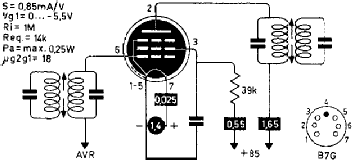
DF96
|
|
|||||||||||||||||||||||||||||||||||||||||||
|
Hits: 16845 Replies: 3
DF96 Filament efficiency
|
|||||||||||||||||||||||||||||||
|
Joe Sousa
10.May.10 |
1
Fellow Radiophiles, The 25mA filament draw of the xx96 tube line is probably the lowest of the tube era. It is half of the 50mA drawn by preceeding generation of tubes like the DK92 and DF92, with similar performance, otherwise. This very low current draw intrigued me for a while. Could it be that the xx96 tubes just ran at a lower temperature because of a much more efficient oxide coating? I made a few simple measurements to attempt an answer to this question. The principle of the measurement is to estimate filament temperature from the rise in the resistance of the tungsten filament, at operating current. The estimated temperature values in the following table are useful to compare the two tubes, which are made with a similar structure, but they don't take into account the slight non-linearity of the tungsten resistance vs temperature curve. These temperatures are also estimated from an average rise in filament resistance, which includes the cool part of the filament at the attachment wires and the highest resistance part at the center of the filaments, that produces the largest emission.
With the limitations I just mentioned, it is still possible to draw some conclusions: The filament in the DF96 is substantially thinner than the DF92, as suggested by the initial room temeprature resistance values. This thinner filament takes less power to reach a given temperature. This contributes to a power savings. The resistance increase under operating power is higher for the DF96, suggesting a higher running temperature. This helps the filament efficiency very much, if my estimate of an additional 161oK (same as oC) is anywhere near correct, because this region of emission versus temperature is usually quite steep. Perhaps the filament coating of the DF96 is improved, but a thinner filament running at a higher temperature is a very plausible explanation for the impressive emission efficiency of the DF96. Another circumstancial bit of evidence is the relatively short life that the xx96 low current filaments seem to have. A hotter temperature usually means a shorter tube life. Any further information about the 25mA filaments would be appreciated. Perhaps something was published in Funkschau when these tubes were launched on the market. Best regards, -Joe |
||||||||||||||||||||||||||||||
|
Roy Johnson
11.May.10 |
2
An interesting piece of investigation, Joe, thank you. I suppose that they followed on from some of the earlier tubes such as the DAF40 and DAF41 from about 1948. There had been improvements to emission/power ratios for the miniature types derived for military applications. Whether this was achieved solely by elevated temperature needs further research. However, we probably need to look earlier than the 1953 time frame. Certainly the Philips group seem to have been advanced in this area so possibly something may be in the "Philips Technical Communications" if anyone has these to hand. Best regards, Roy |
||||||||||||||||||||||||||||||
|
Joe Sousa
16.May.10 |
3
Thanks for the kind words, Roy. The evolutionary differences between the DF92 from 1949 and DF96 from 1953, don't stop at the filaments. Half the plate current: A cursory inspection of their typical operation reveals that the DF96 not only draws half the filamentary current it also draws about half the plate current, yet the DF96 transconductance dropped less than 20%. But the increased 1Meg plate resistance of the DF96 makes it possible to realize higher gain stages than with the lower 350k resistance of the DF92. Higher voltage gain: This plate resistance difference is significant for IF transformer loads of several hundred kOhm at resonance. For example, consider an 455kHz IF transformer with a 100pF&1.22mH and Q=100, then the equivalent resistive load at resonance is XC or L*Q=350k. The intrinsic voltage gain of the two tubes (μ=S*Ri), which is to say the highest possible voltage gain that can be realized with an infinite load impedance, is 360 for the DF92 and 890 for the DF96. The DF96 can produce nearly twice the voltage gain with the IF transformer example. More effective automatic gain control: The two curve families also reveal a cut-off curve for the DF96 that starts to reduce gain with about half the AVR bias of the DF92. The improved AVR compression of the DF96 in combination with the higher intrinsic voltage gain μ, produce detected levels that vary less in amplitude btween strong and weak stations. This improved compression gives the sensation of improved sensitivity because the volume does not have to be turned up as much for weaker stations. It is now clear that significant grid design difference exists between the DF92 and DF96, that account for 50% filament and plate power savings, along with improved gain. Regards, -Joe |
||||||||||||||||||||||||||||||
|
Emilio Ciardiello
22.May.10 |
4
Dear Joe,
even if designed for very feeble currents, several electrometer tubes are characterized by very low current drain. Give a look to these among the many types produced:
Even some subminiature types intended for hearing aids operated with low filament current. CK527AX and CK533AX output amplifiers drained as little as 15mA at 1.25V. Of course the list of tubes requiring low filament current is large and it is difficult to compare the emission efficiency for every type. Best regards, Emilio |
||||||||||||||||||||||||||||||
End of forum contributions about this tube
| Data Compliance | More Information |







